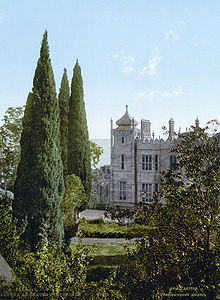- Mikhail Semyonovich Vorontsov
-
Prince Mikhail Semyonovich Vorontsov (Михаи́л Семёнович Воронцо́в) (30 May 1782–18 Nov 1856), was a Russian prince and field-marshal, renowned for his success in the Napoleonic wars, and most famous for his participation in the Caucasian War from 1844 to 1853.
The son of Count Semyon Vorontsov and nephew of the imperial chancellor Alexander Vorontsov, he spent his childhood and youth with his father in London, where he received a brilliant education. During 1803–1804 he served in the Caucasus under Pavel Tsitsianov and Gulyakov, and was nearly killed in the Zakatali disaster (January 15, 1804). From 1805 to 1807 he served in the Napoleonic wars, and was present at the battles of Pułtusk and Friedland. From 1809 to 1811 he participated in the Russo-Turkish War and distinguished himself in nearly every important action.
He commanded the composite grenadiers division in Prince Petr Bagration's Second Western Army during Napoleon's invasion of Russia in 1812. At the battle of Borodino his division was in the front line and was attacked by three French divisions under Marshal Davout. Vorontsov led several counter-attacks, sword in hand. Of the 4,000 men in his division only 300 survived the battle. Vorontsov was wounded, but recovered to rejoin the army in 1813. He commanded a new grenadiers division and fought at the battle of Dennewitz and the battle of Leipzig. In 1814, at Craonne, he brilliantly held out for a day against Napoléon in person. He was the commander of the corps of occupation in France from 1815 to 1818.
 Elizabeth Branicka Vorontsov, by George Hayter
Elizabeth Branicka Vorontsov, by George Hayter
On 7 May 1823 he was appointed governor-general of New Russia, as the southern provinces of the empire were then called, and namestnik of Bessarabia. He may be said to have been the creator of Odessa and the benefactor of the Crimea, both places being graced with his brilliant residences. He was the first to start steamboats on the Black Sea in 1828. The same year saw the start of the Russo-Turkish War of 1828–1829 and Vorontsov succeeded the wounded Menshikov as commander of the forces besieging Varna, which he captured on 28 September 1828. In the campaign of 1829 it was through his energetic efforts that the plague, which had broken out in Turkey, did not penetrate into Russia. But perhaps the best remembered of all is his wife's (née Countess Branicka) liaison with Alexander Pushkin during the latter's stay in Odessa, which resulted in some of the finest poems in Russian language.
In 1844 Vorontsov was appointed commander-in-chief and viceroy of the Caucasus. For his campaign against Shamil, and especially for his difficult march through the dangerous forests of Chechnya, he was raised to the dignity of prince, with the title of Serene Highness. (Others describe his 1845 campaign as the successful withdrawal of his remaining forces after a near-disastrous over-penetration to capture the fort of Dargo [1]). By 1848 he had captured two-thirds of Daghestan, and the situation of the Russians in the Caucasus, so long almost desperate, was steadily improving. In the beginning of 1853 Vorontsov was allowed to retire because of his increasing infirmities. He was made a field-marshal in 1856, and died the same year at Odessa.
The Odessa statue of Prince Vorontsov was unveiled in 1863. In front of the monument stands the Odessa Cathedral with the marble tombs of Prince Vorontsov and his wife. After the Soviets demolished the cathedral in 1936, Vorontsov's remains were secretly reburied at a local cemetery. The cathedral was rebuilt in the early 2000s. The remains of Vorontsov and his wife were solemnly transferred to the church in 2005.
References
- ^ Blanch, Lesley, 'The Sabres of paradise'.
- Blanch, Lesley. "The Sabres of Paradise". John Murray, London, 1960, ISBN=0 85043 403 .
- Gammer, Moshe. Muslim Resistance to the Tsar: Shamil and the Conquest of Chechnia and Daghestan. Frank Cass & Co., London, 1994. ISBN 0-7146-3431-X.
- Rhinelander, Anthony L. H. (1990). Prince Michael Vorontsov: Viceroy to the Tsar. Montreal, Quebec; Kingston, ON: McGill-Queen's University Press. ISBN 0-7735-0747-7.
- Robbins, Richard G.; Rhinelander, Anthony L. H. (October). "Review: Prince Michael Vorontsov: Viceroy to the Tsar". The American Historical Review (The American Historical Review, Vol. 96, No. 4) 96 (4): 1243–1244. doi:10.2307/2165141. JSTOR 2165141. http://www.2odessa.com/wiki/index.php?title=Michael_Vorontsov.
External links
- Online museum of the Vorontsov Family
- Mikeshin, Mikhail. "Mikhail Vorontsov: A Metaphysical Portrait in the Landscape".
 This article incorporates text from a publication now in the public domain: Chisholm, Hugh, ed (1911). Encyclopædia Britannica (11th ed.). Cambridge University Press.Categories:
This article incorporates text from a publication now in the public domain: Chisholm, Hugh, ed (1911). Encyclopædia Britannica (11th ed.). Cambridge University Press.Categories:- 1782 births
- 1856 deaths
- Field Marshals of Russia
- Members of the State Council of the Russian Empire
- Russian commanders of the Napoleonic Wars
- Recipients of the Order of Saint George II Class
- Recipients of the Order of Saint George III Class
- Recipients of the Order of Saint George IV Class
Wikimedia Foundation. 2010.


